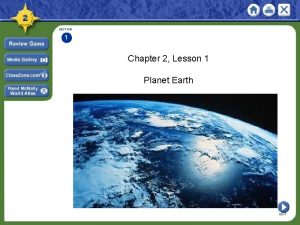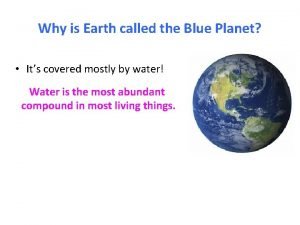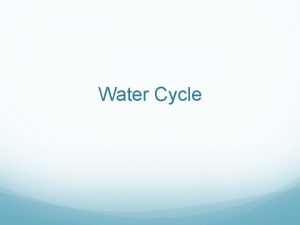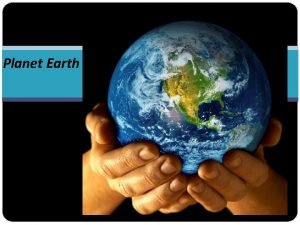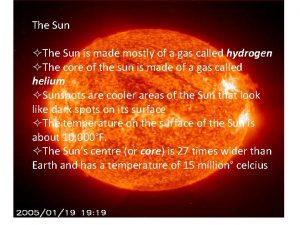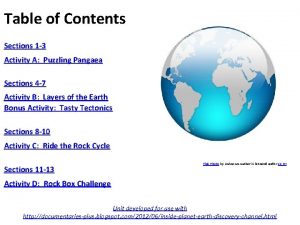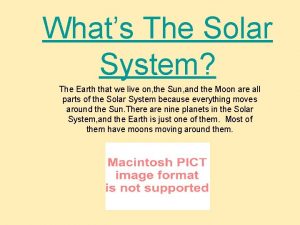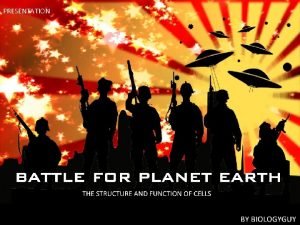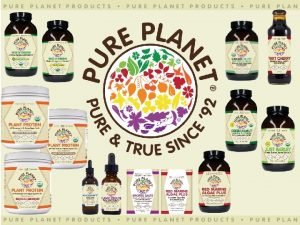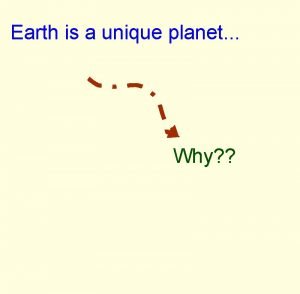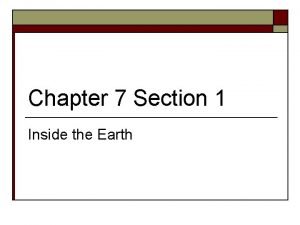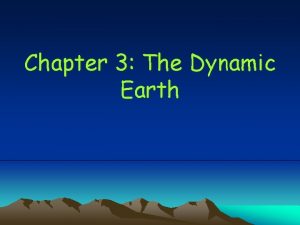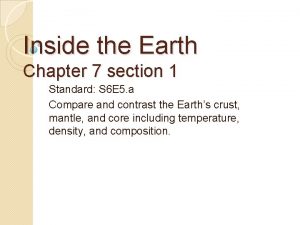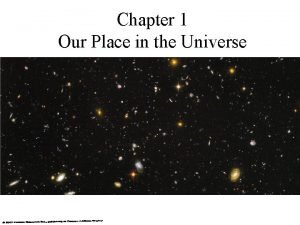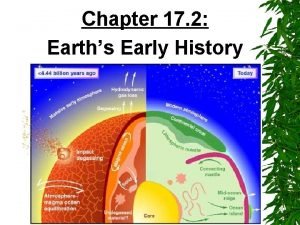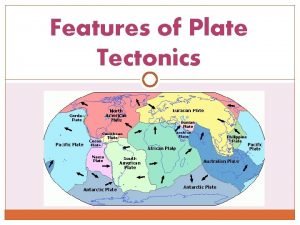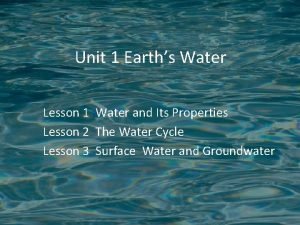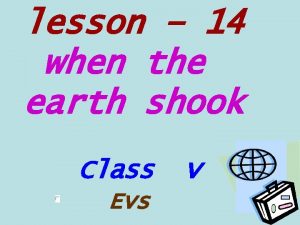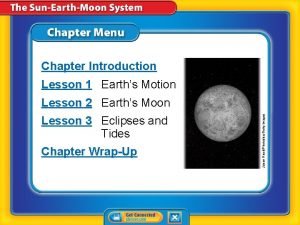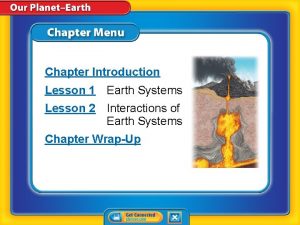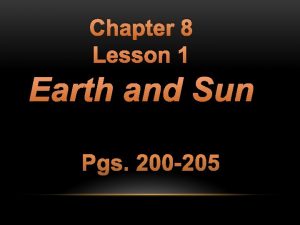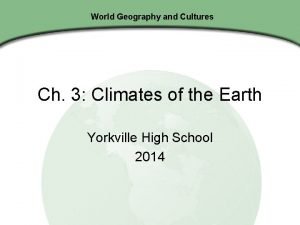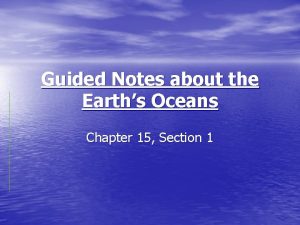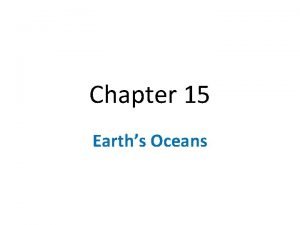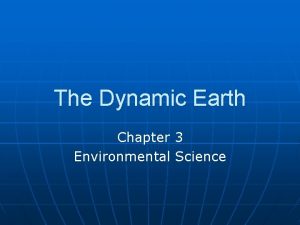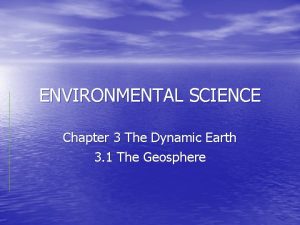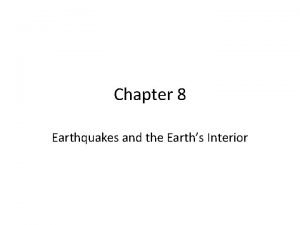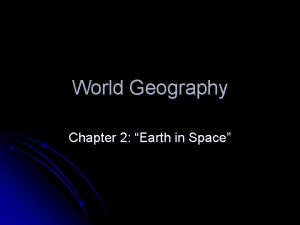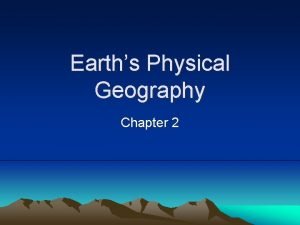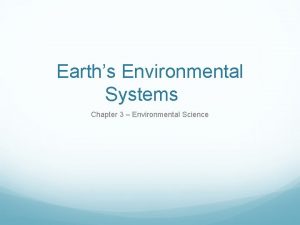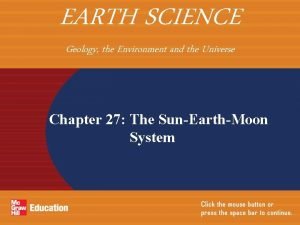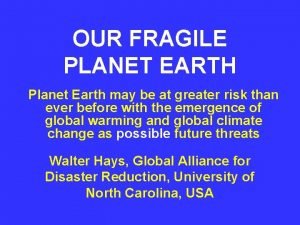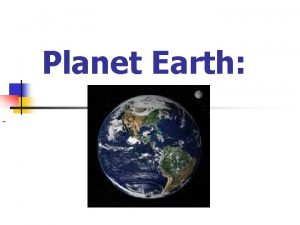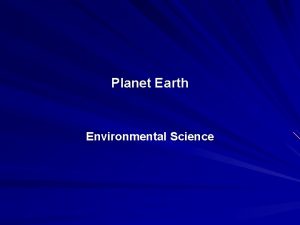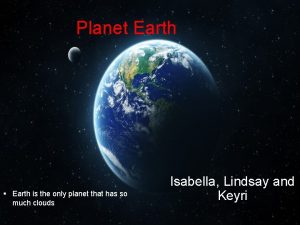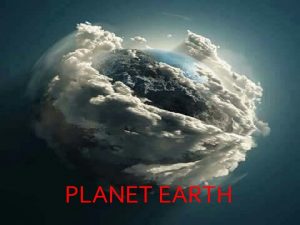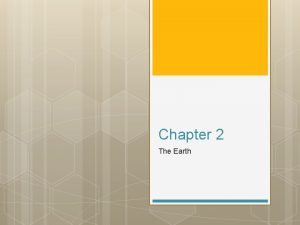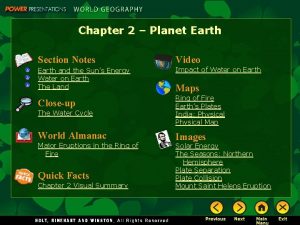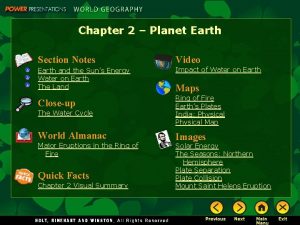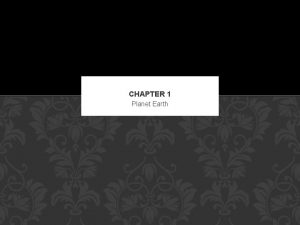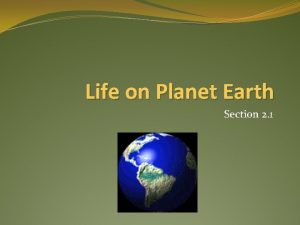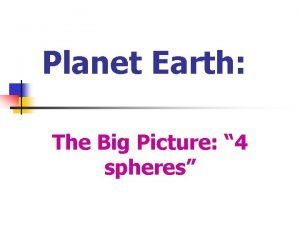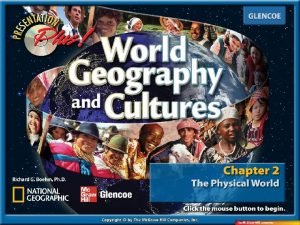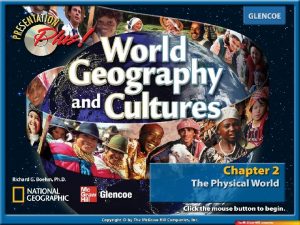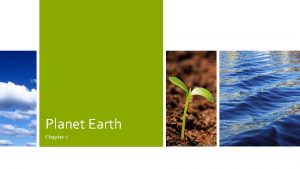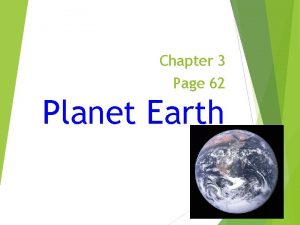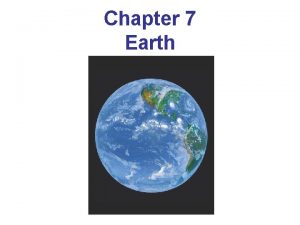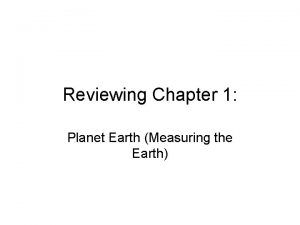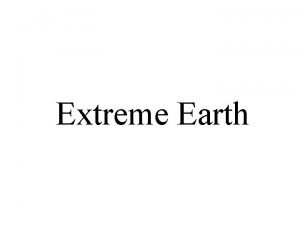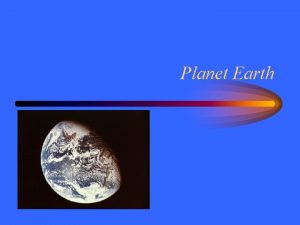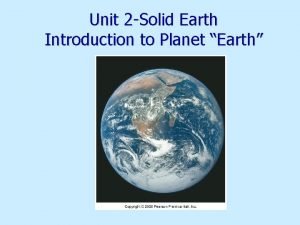SECTION 1 Chapter 2 Lesson 1 Planet Earth












































- Slides: 44

SECTION 1 Chapter 2, Lesson 1 Planet Earth NEXT

SECTION 1 Our Solar System • Earth is part of a large physical system containing countless objects, all of which revolve around the sun. • Eight spheres, called planets, are the largest objects in the solar system. NEXT

SECTION 1 NEXT

SECTION 1 Earth is made of four spheres: • atmosphere, • hydrosphere • lithosphere • biosphere NEXT

SECTION 1 Hydrosphere • includes the liquid and frozen surface water • Groundwater • water vapor in and around oceans, lakes, and rivers on Earth • 70% of earth’s surface NEXT

SECTION 1 NEXT

SECTION 1 Lithosphere • land or surface areas on Earth • including the continents, islands, and ocean basins • 30% of earth’s surface NEXT

SECTION 1 NEXT

SECTION 1 Atmosphere is the layer of gasses surrounding the earth: -protects Earth from radiation, space debris - 78% nitrogen, 21% oxygen NEXT

SECTION 1 NEXT

SECTION 1 • Biosphere- the part of Earth that supports life for all: • People • Animals • Plants Contains atmosphere, lithosphere, and hydrosphere NEXT

SECTION 1 NEXT

SECTION 1 Oceanic Landforms • Continental shelf—sea floor from continent’s edge to deep ocean • Sea floor has ridges, valleys, canyons, plains, mountain ranges NEXT

SECTION 1 NEXT

SECTION 1 Mt. Everest- 29, 028 ft Dead Sea- 1, 312 ft below sea level NEXT

Chapter 2, Lesson 2 Forces of Change World Geography

Forces of Change Earth’s Structure • For millions of years, the surface of the Earth has been moving. • The Earth is composed of three layers— • core at Earth’s center • mantle layer of dense rock on the outer core • crust forming Earth’s surface.


Earth’s Structure -Many scientists believe Earth was once a single land mass called Pangaea, but… -continental drift slowly spread the continents apart.


Earth’s Structure -Plate tectonics describes the activities of continental drift and magma flow -referring to the physical processes that create and shape: - continents -islands -oceans -mountain ranges.


Internal Forces of Change • Mountains are formed when Earth’s giant continental and oceanic plates collide.

Internal Forces of Change • Moving plates sometimes cause Earth’s surface to buckle forming folds • moving plates form cracks called faults.

Internal Forces of Change -Violent movements of Earth’s crust along fault lines are called earthquakes, which dramatically change the surface of the land the floor of the ocean.

Internal Forces of Change • Volcanoes are mountains formed by lava or magma that breaks Earth’s surface.

External Forces of Change • Wind and water break down the Earth’s surface through weathering and erosion.

External Forces of Change • Physical weathering happens when large masses of rock are broken down into smaller pieces.

External Forces of Change • Glaciers are large bodies of ice that move across the Earth’s surface, changing the landscape as they flow.

External Forces of Change • Soil building takes thousands of years of weathering, erosion, and biological activity • influenced by five factors: • climate, • topography, • geology, • biology, and • time.


Chapter 2, Lesson 3 Earth’s Water World Geography

Earth's Water The Water Cycle • Almost all of the hydrosphere is saltwater found in oceans, seas, and some lakes.

The Water Cycle • The amount of water on Earth never changes, but it is constantly moving through the processes of evaporation, condensation, and precipitation.

The Water Cycle • Evaporation is when the sun's energy causes water to change into vapor or gas.

The Water Cycle • Condensation is an excess of water vapor that changes into liquid water after warm air cools.

The Water Cycle • Precipitation is the release of moisture through rain, snow, or sleet.

Earth’s Water Bodies of Salt Water • Seventy percent of the Earth’s surface is water, primarily salt water.

Bodies of Salt Water • Salt water cannot be used for drinking, farming, or manufacturing.

Bodies of Salt Water • Due to a growing population and the need for more freshwater, some countries are focusing on the desalination process, which removes the salt from seawater.

Bodies of Salt Water • Desalination is expensive and is also controversial; critics believe the process has negative environmental and economic impacts.

Earth’s Water Bodies of Freshwater • More than two-thirds of the world’s scarce freshwater is frozen in glaciers.

Bodies of Freshwater • Less than one-third of a percent of freshwater is found in lakes, rivers, and streams and their tributaries.

Bodies of Freshwater • Aquifers and groundwater are important sources of freshwater found underground within the Earth.
 Lesson 1 planet earth
Lesson 1 planet earth Why the earth is called blue planet
Why the earth is called blue planet What is the earth called a blue planet
What is the earth called a blue planet Does the sun moves
Does the sun moves The sun is made mostly of
The sun is made mostly of Inside planet earth video worksheet answers
Inside planet earth video worksheet answers Whats the farthest planet from earth
Whats the farthest planet from earth Battle for planet earth
Battle for planet earth Grade 7 ns term 4
Grade 7 ns term 4 Pure planet sports salts
Pure planet sports salts Why is the earth called unique planet
Why is the earth called unique planet Unit 6 lesson 1 climates of the world
Unit 6 lesson 1 climates of the world Chapter 7 section 1 inside the earth answer key
Chapter 7 section 1 inside the earth answer key Three compositional layers of the earth
Three compositional layers of the earth Chapter 3 the dynamic earth section 1 the geosphere
Chapter 3 the dynamic earth section 1 the geosphere Chapter 7 section 1 inside the earth answer key
Chapter 7 section 1 inside the earth answer key Study guide chapter 10 section 1 meiosis
Study guide chapter 10 section 1 meiosis Sit on the planet chapter 1
Sit on the planet chapter 1 Chapter 1 lesson 1 your total health lesson 1 quiz
Chapter 1 lesson 1 your total health lesson 1 quiz Section 17-2 earth's early history answer key
Section 17-2 earth's early history answer key In what section of earth do earthquakes happen?
In what section of earth do earthquakes happen? Section 17-2 earth's early history
Section 17-2 earth's early history Earth cross section diagram
Earth cross section diagram Lesson 1: earth’s water
Lesson 1: earth’s water The sun-earth-moon system worksheet answers lesson 1
The sun-earth-moon system worksheet answers lesson 1 When the earth shook lesson plan
When the earth shook lesson plan Describing earth's atmosphere lesson 1 answer key
Describing earth's atmosphere lesson 1 answer key Earth's motion worksheet lesson 1 answers
Earth's motion worksheet lesson 1 answers Lesson 1: introduction to the earth
Lesson 1: introduction to the earth Solar opposite lesson analyser
Solar opposite lesson analyser Purpose of sectional view
Purpose of sectional view Define a revolved section view?
Define a revolved section view? Full section view examples
Full section view examples Section 2 describing energy (continued)
Section 2 describing energy (continued) World geography chapter 3 climates of the earth
World geography chapter 3 climates of the earth Chapter 15 earth's oceans study guide answer key
Chapter 15 earth's oceans study guide answer key Chapter 27 human impact on earth resources
Chapter 27 human impact on earth resources In addition to moving horizontally ocean water moves
In addition to moving horizontally ocean water moves Chapter 3 the dynamic earth
Chapter 3 the dynamic earth Chapter 3 the dynamic earth
Chapter 3 the dynamic earth Chapter 8 earthquakes and earth's interior
Chapter 8 earthquakes and earth's interior Chapter 2 the earth in space answers
Chapter 2 the earth in space answers Earth's physical geography chapter 2
Earth's physical geography chapter 2 Environmental science chapter 3
Environmental science chapter 3 Earth moon
Earth moon
